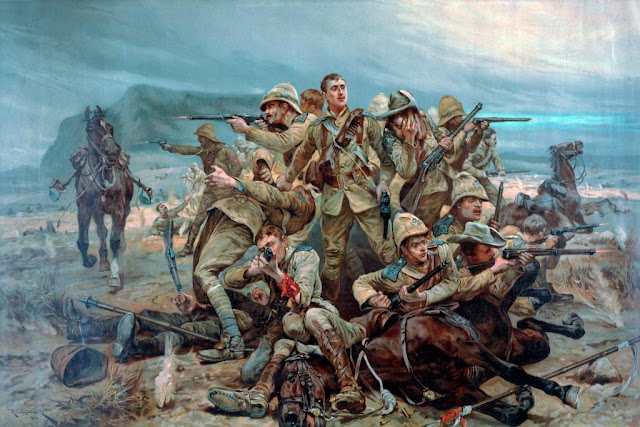Painting History
‘All That Was Left of Them’: The 17th
Lancers at Modderfontein. Painting by Richard Caton Woodville (1856-1927). The
artist depicted the event as a classic colonial ‘last stand’ with officers and
men standing back to back and surrounded during this 1901 battle of the Boer
War. It’s been pointed out that in fact the battle was fought out among the
rocks and stone kraals of the Modderfontein farm, and that the lances and
helmets shown in the painting had been abandoned by this stage of the war
‘History painting’ – a genre
which includes depicting an event or a moment in history,
or a historical figure embodying a clear message – has a long and diverse
tradition
It covers Italian Renaissance artists showing the Adoration of the Magi
to Picasso’s 1937 anti-war painting of the bombing of Guernica pictured above.
It’s no longer fashionable of
course, as speaker Brian Portch showed the audience at one of Fairlynch
Museum’s Coffee Time Talks in November 2019.
‘The Charge of the Light Brigade’ (Crimean War) by
Richard Caton Woodville painted in 1894
Only a few members of
the audience had heard of his subject, the Victorian war artist Richard Caton
Woodville. We enjoyed learning about what turned out to be quite a
controversial subject. Brian clearly admired Woodville’s skill as a painter
while criticising him for ‘selling a myth’ in his glamorising of war.
Ultimately, as Brian
observed, khaki uniforms would make difficulties for Woodville; photography
would finally destroy the illusion that he aimed to create in his paintings by revealing the
horrors of war. Most of Woodville’s work is now in storage at museums.
The role of ‘history painting’ was to plummet even further in
the twentieth century, disappearing almost entirely from art circles following
the breakup of empire after the Second World War.
Some people rather rudely say
that nothing happens in Budleigh but I wondered whether any important moments
worthy of a ‘history painting’ may have occurred in our area.
The
painting was displayed for the third time at Fairlynch Museum in 2018 to mark
the 400th anniversary of Raleigh’s death
The most obvious example of a
locally inspired ‘history painting’ is ‘The Boyhood of Raleigh’ by the great
Pre-Raphaelite artist Sir John Everett Millais. Exhibited at London’s Royal
Academy in 1871 following Millais’s stay in Budleigh, it depicts a totally
imagined event - with loads of artistic license – and with the intention of
inspiring a younger generation to go out and found new outposts of the British
Empire.
The only other painting of a historical event
linked to our area is this painting in Fairlynch Museum’s collection entitled
‘A Revenue Cutter Apprehends the Smuggler Jack Rattenbury off Budleigh
Salterton’.
This early 19th century East Devon character had
many narrow escapes in his violent confrontations with customs officers. He was
clearly a tough and wily customer judging by his memoirs where he wrote about
his exploits, including one incident which took place in Budleigh Bay.
The scene was evoked in local
artist Peter Goodhall's painting, specially commissioned and acquired by the
Museum in 1983.
Can you think of any other scenes
from local history that deserve to be painted?
Meanwhile have a look at another
blog by Budleigh artist John Washington. His latest post explains how he is
tackling a ‘history painting’ based on an incident in the life of East
Budleigh-born Roger Conant. https://www.johnwashingtonartist.com/blog.html
You can access other posts on this blog by going to the Blog Archive (under the ‘About Me’ section), and clicking on the appropriate heading.








Comments
Post a Comment